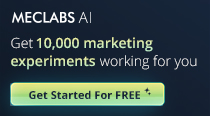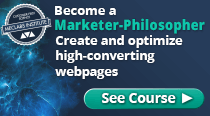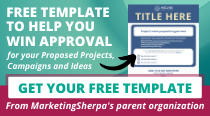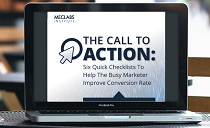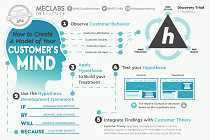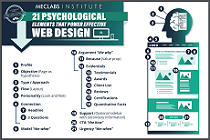April 03, 2003
Case Study
SUMMARY:
If you are doing any email newsletters or broadcast marketing, definitely scroll down to the results section of this Case Study to get some fascinating data on what works for Zacks.com.
Also, of course if you are selling online ads or subscriptions, or even financial services, this Case Study is for you.
|
|
CHALLENGE
"June 2001 was the low-point. We'd gone from five
million pageviews per month to 800,000. Nobody was buying
advertising. It was going straight to the toilet and losing
$50,000 a month," remembers Stephen Reitmeister EVP Zacks
Internet Group.
The site's parent company, Zacks, had four different lines of
business:
1. Selling investment research to financial institutions,
2. Licensing content to Web sites,
3. Selling Zacks' Premium site subscriptions to individual
investors,
4. Selling ads on Zacks.com free info site for individual
investors
Due to the stock market slump, revenues for three out of four
were in the tanker. The only thing that was working still was
selling individual subscriptions to the Premium site, which
Reitmeister headed.
Management decided he was a man for a challenge, so they moved
him to Zacks.com. Reitmeister's goal was to turn it around, from
rags to riches. Could he make no-cost content pay off?
CAMPAIGN
First the team repositioned the site to give it a
strong brand for a recession and beyond. Instead of being the
place where you could find a whole bunch of data, it became the
site where you could learn how to "Profit From the Pros."
Reitmeister explains, "As in, 'It's tough to make money in the
stock market. Zacks.com will track down those rare few
professionals with a track record of beating the Street and bring
their profitable insight to individual investors.'"
It put the human element back into financial data.
Next the team focused on developing two distinct revenue streams:
-> Revenue Stream #1: Selling 3rd Party Newsletter Subscriptions
Reitmeister figured since he'd already proven he could market
Zacks' Premium subscriptions successfully, why not try selling
other publishers' newsletters to Zacks.com visitors?
It was not a new idea. Several companies in the past had tried
acting as sales agents for print newsletter publishers.
Reitmeister had watched their attempts carefully and learned
from their mistakes.
Then, he and his team combed through the hundreds of print
newsletters published for the personal investor marketplace and
created a hit list of the best. The deal: Zacks.com would sell
and electronically fulfill those publishers' newsletters to
buyers on a month-to-month until forbid basis.
All the publisher had to do was hand over some promotional copy
for Zacks.com's in-house copywriters to work from, send in a copy
of each issue as it came out, and sit back and enjoy the
revenues.
The one key rule was that publishers would not be allowed to
promote direct renewals to these accounts.
The accounts essentially belonged to Zacks.com, not the
publisher. Publishers also could not put in printed inserts for
ancillary products to raise sales, because everything was going
to be fulfilled via PDF. However, they could promote ancillaries
in the text of their newsletters.
Initially publishers were wary, mainly because they feared the
site's promotional efforts would be torn by loyalties to its
sister the Premium offering.
"They didn't believe us at first," notes Reitmeister. "We told
them of course you will be the most important thing to us." The
trust had to be built one publisher at a time.
The marketing team used four tactics to market these 3rd party
subscriptions
a. Ongoing promotions and articles on the Zacks.com site
featuring headshots of the publishers as "Featured
Experts."
b. Co-branded pages with the same type of featured expert
content and promotions on hand-picked partner sites such as
Briefings.com (link to sample co-brand page below).
c. Continual promotions in two different no-cost weekly email
newsletters, "Profit from the Pros: Best of Wall Street"
sent on Mondays and "Profit from the Pros: The Zacks Way"
sent on Wednesdays. Zacks.com site visitors could sign up
for either or both of these as separate choices. (Link to a
sample of each below.)
d. Two-step broadcast email campaigns focused on promoting
just one single newsletter. The first step was sent to
everyone who had signed up to the promotional list(yet
again, a separate choice from the newsletter lists, which
is a best practice in gathering names) on Thursdays.
The second step, a follow-up note with a slightly different
subject line was sent just to the "responders" slice
(people on the broadcast list who have responded favorably
to a promotion in the past) on the next Tuesday. (Links to
a sample of both mailings below.)
Reitmeister's team tested a wide variety of factors to make these
email pitches work, including time of day, from line, subject
line and text versus HTML.
One of the most critical tests was copy length. At first the
team stuck to very short copy with links well-above the fold.
Then Reitmeister asked them to try emailed letters that
printed out to 2,3,4 and even five-pages.
Classic proven print campaigns for these types of newsletters are
almost always extremely long on copy. "It's going to be a 16-
page letter with all kinds of lift notes," says Reitmeister.
"The bigger the piece the more engaged they are by it. These
folks are information gatherers. It's the nature of the
business. They want to hear more from this expert newsletter
person. I liken it to 30-minute infomercials on TV."
Just as infomercial producers test how far along they will
take you before they start promoting the exact phone number to
call to get the offer, Reitmeister's team began to test how far
down on the page the first link to the order form should be.
However, in all cases the offer was the generally same: Sign up
for a 30-day no-cost trial to a particular newsletter. Trials
are required to hand over a working credit card number to start,
but it is not charged until day 31, and they get a premium report
as a bonus gift at the start of the trial.
"The premium is a big part of how we get people on board,"
explains Reitmeister. "This is what's been successful in the
past. In investment newsletter direct marketing, it's all about
the premium."
Once trials start in the system, Zacks.com depends on the quality
of the product itself to convert them into staying on board.
"It's all about the advice," says Reitmeister. "Once they start
test driving, almost nothing you can tell them will make a
difference. If the advice stinks, no amount of marketing can
change their mind about the product."
-> Revenue Stream #2: Selling Advertising on Zacks.com, Ezines
and a Network of 3rd Party Sites
First Reitmeister cleaned house, paring his ad sales team down to
his two most effective sales reps. (He is now hiring a third.)
Then he extended the site's new brand positioning to the media
kit. Instead of being a site selling a lot of traffic, he wanted
to be a site selling the highest quality traffic.
He says, "It still cracks me up when some big traffic sites play
it like 'We're huge, we're like a TV network online.' Don't
tell me you're the largest, tell me about the quality of your
visitors. By definition, the largest are also the most average,
and they try and sell as if it's premium. They have very large
networks of average individuals."
Instead, the Zacks.com site trumpeted the fact that it had an
unusually high number of wealthy, involved investors. Being
niche meant being a better media buy.
As advertisers came back to the site, Reitmeister then focused on
expanding his inventory in four ways:
a. Expanding the readership of Zacks.com email newsletters
through advertising on Gator, Overture, and aggressive text-link
ad campaigns on targeted sites such as CBS MarketWatch.com which
featured strong offers such as a link reading "Free Stock
Analysis of Agilent Technologies Inc (A)" which appears on the
site's profile page for that particular company.
Instead of sending clicks from these links to the regular
Zacks.com home page, the marketing team devised special landing
pages which focused 100% on getting clicks to convert to signing
up for Zacks.com no-cost email newsletters. (Link to sample
landing page below.)
"The original registration form asked for all the information on
one page. We broke that into two pages. The first page only
asked for email, and page two for other information, which we
found to be very effective."
No, these special landing pages do not include regular Zacks.com
site navigation because Reitmeister wants to focus visitors on a
single direction.
The Zacks.com team uses an internal database they call a Customer
Acquisition Model to track and forecast the lifetime value of all
new sign-ups they get through these campaigns, including ad
sales against their eyeballs and possible subscription purchases.
Reitmeister says, "I truly think it's the best thing we ever did.
You only want to spend as much as you get in return. If a new
client is worth $25, you have to get that person for no more than
$15 or $20. Then you keep spending marketing dollars until that
marginal value equals one."
b. Offering co-registrations for sale on all Zacks.com sign-up
forms. Zacks.com can actually start making revenues with a
name the very instant than name signs up, even if that person
has not been over to the main Zacks.com site or seen a single
Zacks.com email campaign yet.
c. Selling sponsorships in the two weekly email newsletters.
d. Selling ads on a new hand-crafted network of 3rd-party
sites offering five million pageviews a month. Reitmeister
developed this idea after Zacks.com's inventory began selling
well again.
"We didn't take everybody, just those with good traffic
attracting high net worth customers, so we could continue to sell
at a higher rate than the competition. It wasn't too hard to get
those folks on board - so many small sites were suffering. 'I've
got a million pageviews and I'm making $200 a month.' It was so
sad."
The site had to allow a few of Zacks.com's current advertisers to
test ads at no cost for a week or two to prove they could provide
quality clicks. "250,000-500,000 impressions is enough
information to form an opinion on whether we want to partner with
someone."
The site also had to hand over ad sales and serving completely to
Zacks.com's team, or at the very least the monster chunk of it.
"A couple maintained certain parts of their property for
themselves; but, we were exclusive with everything we repped. If
you're non-exclusive, then you're in bidding wars, both sides
trying to beat each other up for the sale."
However, Reitmeister had no problem with selling ads to his
direct competitors, and even to newsletter publishers whose
titles he also sold. "Some of our biggest advertisers are
newsletters and my competition. If they can make money, and we
can make money, I'm doing a disservice if we don't allow it. I
won't allow my guys to sell cheap, cheap to them though."
RESULTS
Zacks.com has increased revenues by 600%, with a
very) healthy profit.
Revenues break down roughly to 30% from 3rd party newsletter
subscription sales, 50% ad sales to Zacks.com's site, co-reg and
newsletters, and 20% ad sales on the 3rd party network.
More details:
- Of total sales generated by the weekly broadcast promo for a
single newsletter, 60% will come from the Thursday promo which
goes to about 430,000 names, and 40% will come from the Tuesday
follow-up which goes to 160,000 names.
- Email tests revealed that 10 A.M.- 2 P.M. Central Time are the best
times to send. In fact the results were so conclusive that
Reitmeister warned his service bureau he will not pay for email
that slips outside those boundaries.
- Longer 3-5 page email letters with links below the fold have
proven to be the winners for single promo campaigns, which
breaks the rules but works. "It's counterintuitive, but it works
because you get them engaged."
- Test results on "from" lines have taken a 360 in the past
year. Originally a person's name worked best. However, so many
unwanted bulk emailers try to psych people out with fake names
now, that the market reacts against them. Zacks.com is now the
strongest from name.
- Subject lines that work best are not boasts, but immediate
benefits. Many investment gurus trumpet their past successes,
such as how much their hand-selected portfolio gained in the last
few quarters. However, Reitmeister advises against this tactic
for email.
"If it's a historical claim, they know it's an ad. You're not
giving them a reason to open your email up. Instead, always have
the promise of something they'll learn by opening. '10 stocks to
make it all back now.'"
- Purely promotional email campaigns got a 50% lift when
switched from text to HTML. However, newsletters only got a 10%
lift in clicks. HTML can cost more to send because you are using
more bandwidth, so sometimes that smaller lift may not be worth
it in the end.
- 60% of trial subscriptions cancel before the end of their
month. About 20-30% of the accounts that are charged that first
month, ask for a refund. By the second monthly charge the list
will be down to 28% of original trials. Another 15-20% fall off
in months three and four, and then the stay rate steadies out to
90% from then on.
- Gator ads have proven very successful, however, Reitmeister
warns, "We find if we increase the buy too much, it gets
saturated, and it kills off sign up rates. We keep a low level
with them."
- Text links and Overture listings are so successful that
Reitmeister has even changed over his own banners to resemble
them. "Text links are the greatest ad on the planet. It amazes
me how few sites actually sell them," Reitmeister says.
He adds, "Outside of our email, our site's text links are the
most desirable property we have. I get about a 2.97% click rate
on my own text links on remnant property on my site. I've seen
it do 1-1.5% for other people. Banner ads average .25%"
He says the best creative for text links is usually only a few
words. Often the words that work well for email subject lines
are perfect for text-links too.
- Zacks.com's newsletters top ad spots are often sold out for
6-7 months in advance.
- Although they were initially leery of quality, most of
Zacks.com's advertisers have tested and renewed on the network.
"I am most proud that our success came from serving customers
better and growing revenue; not by cutting jobs" says
Reitmeister. "In fact we have grown from 11 to 16 employees for
Zacks.com. Hope our story can help others."
Link to samples of email campaigns, newsletters and landing page:
http://www.marketingsherpa.com/zack/ad.html
http://www.zacks.com


